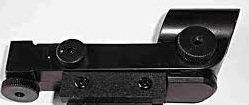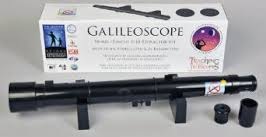Well march is almost out and i’ve managed just 4 nights observing due to bad weather. not to say i’ve missed much but buying new equipment and not being able to test drive it gets a little frustrating.
My first new purchase this month was a new red dot finder for one of my 60mm scopes. it works a treat and far easier to use than the regular 5×25 upside downy wrong way roundy that came as an included accessory. The RDF is a cheapo Celestron type with variable brightness. as usual with RDF’s it needs to be on it’s dimmest setting to be useable, especially in slightly light polluted skies.
A friend had bought a really cheap (£7.50) RDF BB gun sight, it looks okay for the money but has a mirrored lens, once the mirror coating was removed the sights work okay but dont have adjustable brightness. looks like a project that may turn out nearly as expensive as buying an astronomy specific RDF.
Galileoscope
Back to the title… the 50mm scopes this month are the renowned and well reviewed Galileoscope. I managed to pick one up from ebay US, cheap price and reasonable shipping meant it arrived at my door for a mere £22.50.
To give you an idea, Galileoscopes available to UK buyers are usually 2-3 times that price which is why i bought it. When i have a little more time i’ll build it and write a review, i doubt i’ll be able to add any more insight to the many decent reviews already available. I will be modifying it, so maybe a quick review and a post based on the upgrades may be in store.
Unicon 50×600 Refractor.
The other 50mm scope is a Unicon 50×600 which i’ve only managed an hour of observing with. Jupiter showed both NEB and SEB and pinpoint moons at 60x mag using a 10mm .965 huygens. Unfortunately seeing was shakey so i was limited to the old favourites of small telescope users, Pleiades, Beehive, Hyades, a safari around Orion,which i wish i’d done at the start as the trapezium was only showing 2 stars and the doubles around orions belt were hit and miss due to cloud. Appearance wise the Unicon is a budget scope, plastic lens cell and all plastic .965 focuser, the tube is aluminium and reasonably well coated in white enamel. the cost cutting also runs into the finder and finder mount. The 2 screws to mount the finder screw straight into the Aluminium tube, cheap and tacky which is odd as the Diagonal is a metal affair with decent finish. It looks like the extent of cost cutting ends there as the Objective lens gives crisp clear views with no discernable Chromatic Aberation. Maybe lunar observing will show up any edge colouring but from first light this scope appears to be a keeper. The included tripod is Alt-Az with no slow controls. While vibration absorption is good the same cant be said for the Alt locking nut, which despite a good tightening still doesnt “lock” the scope in place. it stays steady enough for a few minutes but eventually gives in to gravity and starts tilting backwards. oh i nearly forgot.. the Unicon cost £27 including delivery, which these days doesn’t even buy you a decent eyepiece….
When i get enough time i’ll post a few bits about some of the small scopes i own. Nearly all have cost very little to buy and despite what the “Big Dob Brigade” say most are really very good telescopes.

